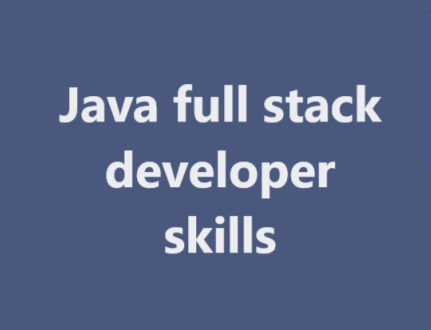
Introduction
Full Stack Developers, who can create full apps, have emerged as innovators in the rapidly changing field of web development. Those that are skilled in Java stand out among these active developers because they use its powerful features to create scalable and smooth solutions. This examination delves into the fundamental abilities that characterize a Java Full Stack Developer and provides a road map for individuals starting this fascinating and diverse career path.
The need for experts who can handle both the front-end and back-end facets of web development has increased as technology develops. With a broad range of skills, a Java Full Stack Developer may tackle any part of the development process, from creating an engaging user interface to putting strong server-side logic in place. This article clarifies the essential abilities of a skilled Java Full Stack Developer, offering guidance to prospective developers as well as those looking to advance their current level of proficiency.
Whether you’re interested in learning more about the exciting field of Full Stack Development with Java, attending an online bootcamp, or just want to brush up on your skills, this guide will act as a compass to help you navigate the complex skill set needed. Come with me as we explore Java Full Stack Development, where creativity and expertise collide, and each line of code creates a smooth online experience. Additionally, discover the convenience of advancing your skills through a comprehensive full stack bootcamp online.
Brief Overview of Full Stack Development
Full Stack Development is a comprehensive strategy that covers both the client-side (front-end) and server-side (back-end) of applications in the vast field of web development. Similar to a flexible architect, a Full Stack Developer is skilled in multiple technologies and frameworks and able to create, optimize, and manage an entire online solution.
In the development industry, full stack developers are effectively jacks of all trades because they have the knowledge and abilities to work with databases, servers, systems engineering, and client-side interactions. This adaptability guarantees a thorough grasp of the overall application architecture while also streamlining the development process.
Users immediately engage with a web application through its front-end. It consists of the application’s general appearance and feel as well as its visual components and user interfaces. The backend, on the other hand, consists of database administration, server-side programming, and the application’s logic.
Because Full Stack Developers can move fluidly between both sides of the development spectrum, their demand has increased dramatically in recent years. This synopsis lays the groundwork for a deeper dive into the competencies needed for a Full Stack Developer with a focus on Java—a language well-known for its adaptability and strength in the development environment. We’ll discover the essential elements that characterize a proficient Java Full Stack Developer when we get into the details.
Importance of Java in Full Stack Development
Within the dynamic realm of Full Stack Development, Java is a fundamental programming language that is essential to the development of dependable and expandable applications. Because of its wide ecosystem, platform freedom, and versatility, it is a top choice for Full Stack Developers who want to construct comprehensive and effective solutions. Let’s examine Java’s role in Full Stack Development and how its capabilities help make contemporary web apps successful.
Versatility and Platform Independence:
Java’s “Write Once, Run Anywhere” design enables programmers to create code on one platform and execute it, unchanged, on any other compatible platform. A key component of Full Stack Development, Java’s platform neutrality makes it a potent language for creating apps that can be implemented in a variety of settings.
Rich Ecosystem and Libraries:
Java comes with a large library and framework set that makes it easier to construct applications quickly. These resources are used by Full Stack Developers to expedite different parts of the development process, such as developing sophisticated back-end features and designing responsive front-end interfaces.
Scalability and Performance:
Java is a good choice for Full Stack Development because of its performance features, which include its capacity to manage heavy traffic loads and large-scale applications. The language’s strong multithreading and memory management features let programmers create scalable, high-performing web applications.
Object-Oriented Programming (OOP):
As Java follows the tenets of Object-Oriented Programming (OOP), software development may be done in an organized and modular manner. As a result, the codebase is more reusable, maintainable, and flexible to changing requirements, enabling Full Stack Developers to design modular components.
Security Features:
When it comes to web development, security is the top priority. A comprehensive collection of APIs for encryption, authentication, and access control are among the security features that come pre-installed in Java. The security features of Java are used by Full Stack Developers to guarantee the privacy and accuracy of the data in their apps.
Community Support and Documentation:
Java has a large developer community and substantial documentation, which adds to the wealth of resources available to developers. Full Stack Developers can quickly solve problems, get access to tutorials, and keep current on best practices, which promotes teamwork and knowledge exchange.
Integration Capabilities:
Many times, full stack development entails merging different parts and services. Java’s seamless integration features make it easy for developers to link various application components. In order to get a coherent and well-integrated Full Stack solution, this is essential.
Key Skills for a Java Full Stack Developer
Proficiency in Java Programming
A Java Full Stack Developer must have a solid understanding of Java grammar, object-oriented concepts, and how to develop scalable, effective code.
Front-End Technologies (HTML, CSS, JavaScript):
Having a strong grasp of front-end technology is essential. The three main components of front-end development are HTML for structuring, CSS for styling, and JavaScript for dynamic and interactive web sites.
Java Frameworks (Spring Boot, Hibernate):
Backend development is made more effective by frameworks like Spring Boot and Hibernate, which offer resources for creating scalable, reliable applications and streamlining database connections.
Database Management (SQL, NoSQL):
Effective data management requires knowledge of both NoSQL databases, such as MongoDB, and SQL databases, such as MySQL, PostgreSQL.
Version Control (Git):
Version control and cooperation are made possible with Git. It is a tool that a Full Stack Developer should know how to use well to track changes in the codebase.
Server-Side Development:
It’s critical to comprehend server-side development. Java’s large library makes it possible for programmers to construct server-side logic quickly.
Web Application Architecture:
System design that is scalable and maintainable benefits from an understanding of various web application architectures.
RESTful APIs:
Proficiency in developing and utilizing RESTful APIs is crucial for facilitating smooth communication among various web application components.
Knowledge of Cloud Platforms:
Developing and scaling apps is made easier for developers by having experience with cloud platforms such as AWS, Azure, or Google Cloud.
Understanding of DevOps Practices:
The development lifecycle is improved by integrating DevOps methods, which provide seamless communication between the development and operations teams.
Testing (Unit Testing, Integration Testing):
The functionality and dependability of the produced apps are ensured by writing unit tests and carrying out integration testing.
Problem-Solving and Debugging Skills:
Debugging and problem-solving abilities are essential for locating and fixing problems during the development process.
Continuous Learning and Professional Growth:
A dedication to lifelong learning is essential, considering how quickly technology is developing. It is important for Full Stack Developers to remain current with the newest frameworks, tools, and best practices.
Conclusion:
Any aspirant Java Full Stack Developer will undergo a transformation after mastering the techniques described in this tutorial. Whether you’re learning on your own or through an online Full Stack bootcamp, these abilities will enable you to build creative, scalable, and high-performing web applications. Accept the fluidity of full stack development and set out on a path to mastery as a Java full stack developer.


















